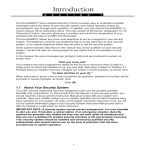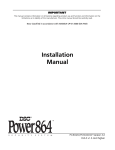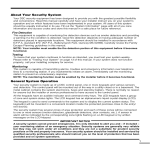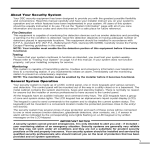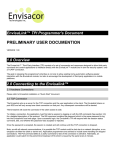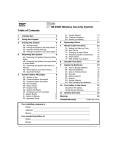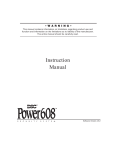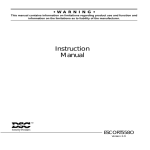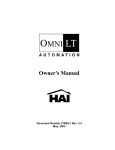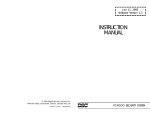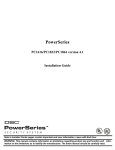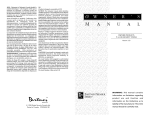Download Escort
Transcript
• W A R N I N G •
This manual contains information on limitations regarding product use and function
and information on the limitations as to liability of the manufacturer.
Instruction
Manual
ESCORT558OTC
Version 3.O
FCC COMPLIANCE STATEMENT
CAUTION: Changes or modifications not expressly approved by Digital Security
Controls Ltd. could void your authority to use this equipment.
This equipment generates and uses radio frequency energy and if not installed
and used properly, in strict accordance with the manufacturer’s instructions, may
cause interference to radio and television reception. It has been type tested and
found to comply with the limits for Class B device in accordance with the
specifications in Subpart “B” of Part 15 of FCC Rules, which are designed to
provide reasonable protection against such interference in any residential
installation. However, there is no guarantee that interference will not occur in a
particular installation. If this equipment does cause interference to television or
radio reception, which can be determined by turning the equipment off and on,
the user is encouraged to try to correct the interference by one or more of the
following measures:
• Re-orient the receiving antenna
• Relocate the alarm control with respect to the receiver
• Move the alarm control away from the receiver
• Connect the alarm control into a different outlet so that alarm control
and receiver are on different circuits.
If necessary, the user should consult the dealer or an experienced radio/
television technician for additional suggestions. The user may find the
following booklet prepared by the FCC helpful: ”How to Identify and
Resolve Radio/Television Interference Problems.” This booklet is
available from the U.S. Government Printing Office, Washington, D.C.
20402, Stock # 004-000-00345-4.
IMPORTANT INFORMATION
FCC Registration Number: F53CAN-22830-KX-N,
Number: 0.2B, USOC Jack: RJ-31X
Ringer Equivalence
MALFUNCTION OF THE EQUIPMENT In the event that this equipment should
fail to operate properly, the customer shall disconnect the equipment from the
telephone line to determine if it is the customer’s equipment which is not working
properly, or if the problem is with the telephone company network. If the problem is
with this equipment, the customer shall discontinue use until it is repaired.
AVIS: L’étiquette de l’Industrie Canada identifie le matériel homologué. Cette
étiquette certifie que le matériel est conforme à certaines normes de protection,
d’exploitation et de sécurité des réseaux de télécommunications. Industrie Canada
n’assure toutefois pas que le matériel fonctionnera à la satisfaction de l’utilisateur.
Avant d’installer ce matériel, l’utilisateur doit s’assurer qu’il est permis de le
raccorder aux installations de l’entreprise locale de télécommunication. Le matériel
doit également être installé en suivant une méthode acceptée de raccordement.
L’abonné ne doit pas oublier qu’il est possible que la conformité aux conditions
énoncées ci-dessus n’empêchent pas la dégradation du service dans certaines
situations.
Les réparations de matériel homologué doivent être effectuées par un centre
d’entretien canadien autorisé désigné par le fournisseur. La compagnie de
télécommunications peut demander à l’utilisateur de débrancher un appareil à la
suite de réparations ou de modifications effectuées par l’utilisateur ou à cause de
mauvais fonctionnement.
Pour sa propre protection, l’utilisateur doit s’assurer que tous les fils de mise à la
terre de la source d’énergie électrique, les lignes téléphoniques et les canalisations
d’eau métalliques, s’il y en a, sont raccordés ensemble. Cette précaution est
particulièrement importante dans les régions rurales.
AVERTISSEMENT: L’utilisateur ne doit pas tenter de faire ces raccordements
lui-même; il doit avoir recours à un service d’inspection des installations électriques,
ou à un électricien, selon le cas.
L’indice de charge (IC) assigné a chaque dispositif terminal indique, pour éviter
toute surcharge, le pourcentage de la charge totale qui peut être raccordée à un
circuit téléphonique bouclé utilisé par ce dispositif. La terminaison du circuit bouclé
peut être constituée de n’importe quelle combinaison de dispositifs, pourvu que la
somme des indices de charge de l’ensemble des dispositifs ne dépasse pas 100.
L’Indice de charge de ce produit est 2.
TELEPHONE CONNECTION REQUIREMENTS Except for the telephone
company provided ringers, all connections to the telephone network shall be
made through standard plugs and telephone company provided jacks, or
equivalent, in such a manner as to allow for easy, immediate disconnection of the
terminal equipment. Standard jacks shall be so arranged that, if the plug
connected there is withdrawn, no interference to the operation of the equipment
at the customer’s premises which remains connected to the telephone network shall
occur by reason of such withdrawal.
INCIDENCE OF HARM Should terminal equipment or protective circuitry
cause harm to the telephone network, the telephone company shall, where
practicable, notify the customer that temporary disconnection of service may be
required; however, where prior notice is not practicable, the telephone company
may temporary discontinue service if such action is deemed reasonable in the
circumstances. In the case of such temporary discontinuance, the telephone
company shall promptly notify the customer and will be given the opportunity to
correct the situation. The customer also has the right to bring a complaint to the
FCC if he feels the disconnection is not warranted.
CHANGE IN TELEPHONE COMPANY EQUIPMENT OR FACILITIES
The Telephone Company may make changes in its communications facilities,
equipment, operations or procedures, where such actions is reasonably required
and proper in its business. Should any such changes render the customer’s
terminal equipment incompatible with the telephone company facilities the
customer shall be given adequate notice to the effect of the modifications to
maintain uninterrupted service.
GENERAL This equipment should not be used on coin telephone lines.
Connection to party line service is subject to state tariffs.
RINGER EQUIVALENCE NUMBER (REN) The REN is useful to determine
the quantity of devices that you may connect to your telephone line and still have all
of those devices ring when your telephone number is called. In most, but not all
areas, the sum of the REN’s of all devices connected to one line should not exceed
five (5). To be certain of the number of devices that you may connect to your line,
you may want to contact your local telephone company.
EQUIPMENT MAINTENANCE FACILITY
Digital Security Controls Ltd. 160 Washburn St.Lockport, NY 14094
NOTICE: The Industry Canada label identifies certified equipment. This
certification means that the equipment meets certain telecommunications network
protective, operational and safety requirements. Industry Canada does not guarantee
the equipment will operate to the user’s satisfaction.
Before installing this equipment, users should ensure that it is permissible to be
connected to the facilities of the local telecommunications company. The equipment
must also be installed using an acceptable method of connection. The customer
should be aware that compliance with the above conditions may not prevent
degradation of service in some situations.
Repairs to certified equipment should be made by an authorized Canadian
maintenance facility designated by the supplier. Any repairs or alterations made by
the user to this equipment, or equipment malfunctions, may give the
telecommunications company cause to request the user to disconnect the equipment.
User should ensure for their own protection that the electrical ground connections
of the power utility, telephone lines and internal metallic water pipe system, if
present, are connected together. This precaution may be particularly important in
rural areas.
CAUTION: Users should not attempt to make such connections themselves, but
should contact the appropriate electric inspection authority, or electrician, as
appropriate.
The Load Number (LN) assigned to each terminal device denotes the percentage
of the total load to be connected to a telephone loop which is used by the device, to
prevent overloading. The termination on a loop may consist of any combination of
devices subject only to the requirement that the total of the Load Numbers of all
the devices does not exceed 100.
The Load Number of this unit is 2.
Table of Contents
1: Introduction ..................................................................................................................................... 1
1.1
About Your Security System ................................................................................................ 1
1.2
General System Operation .................................................................................................. 2
1.3
Access Codes ..................................................................................................................... 2
1.4
Audio Help ........................................................................................................................... 2
2: Accessing Your Security System .................................................................................................. 3
2.1
Local Access ....................................................................................................................... 3
2.2
Remote Access ................................................................................................................... 3
2.3
Receiving Incoming Calls ................................................................................................... 3
2.4
What is a Partition? .............................................................................................................. 4
2.5
If You Have a Multiple Partition System ............................................................................... 4
2.6
Fire, Auxiliary and Panic Alarms ......................................................................................... 4
3: Arming and Disarming ................................................................................................................... 5
3.1
Away Arming ....................................................................................................................... 5
3.2
At-home Arming ................................................................................................................... 5
3.3
Disarming ............................................................................................................................ 6
3.4
If An Alarm Sounds While You Are Home ............................................................................ 6
3.5
Alarm Memory ..................................................................................................................... 7
3.6
Bypassing Zones ................................................................................................................. 7
4: Trouble Conditions .......................................................................................................................... 8
5: Setting Escort5580TC Options ...................................................................................................... 9
5.1
Setting The Time and Date .................................................................................................. 9
5.2
Volume Control .................................................................................................................... 9
5.3
Speech Rate Control ......................................................................................................... 10
5.4
Door Chime Feature .......................................................................................................... 10
6: Home Automation ......................................................................................................................... 11
6.1
How to Access the Home Automation Menu ................................................................... 11
6.2
How to Use the Item Control Menu ................................................................................... 12
6.3
Mode Control ..................................................................................................................... 12
6.4
Global Item Control ............................................................................................................ 13
6.5
Output Control Feature ...................................................................................................... 13
6.6
Temperature Control ......................................................................................................... 14
6.7
Accessing Temperature Control from an LCD5500Z Keypad .......................................... 16
6.8
Video Camera Triggering .................................................................................................. 16
7: Programming Access Codes ...................................................................................................... 17
8: Fire and Safety in the Home ......................................................................................................... 18
8.1
Household Fire Safety ....................................................................................................... 18
8.2
Family Escape Planning .................................................................................................... 18
9: Glossary ........................................................................................................................................ 19
i
WARNING Please Read Carefully
System Failures
closed doors. Smoke detectors may not detect smoke from fires on another
level of the residence or building.
Every fire is different in the amount of smoke produced and the rate of
burning. Smoke detectors cannot sense all types of fires equally well. Smoke
detectors may not provide timely warning of fires caused by carelessness or
safety hazards such as smoking in bed, violent explosions, escaping gas,
improper storage of flammable materials, overloaded electrical circuits, children playing with matches or arson.
Even if the smoke detector operates as intended, there may be circumstances
when there is insufficient warning to allow all occupants to escape in time to
avoid injury or death.
This system has been carefully designed to be as effective as possible. There are
circumstances, however, involving fire, burglary, or other types of emergencies
where it may not provide protection. Any alarm system of any type may be compromised deliberately or may fail to operate as expected for a variety of reasons.
Some but not all of these reasons may be:
■ Inadequate Installation
A security system must be installed properly in order to provide adequate protection. Every installation should be evaluated by a security professional to ensure that all access points and areas are covered. Locks and latches on windows
and doors must be secure and operate as intended. Windows, doors, walls, ceilings and other building materials must be of sufficient strength and construction
to provide the level of protection expected. A reevaluation must be done during
and after any construction activity. An evaluation by the fire and/or police department is highly recommended if this service is available.
■ Motion Detectors
Motion detectors can only detect motion within the designated areas as
shown in their respective installation instructions. They cannot discriminate between intruders and intended occupants. Motion detectors do not
provide volumetric area protection. They have multiple beams of detection and motion can only be detected in unobstructed areas covered by
these beams. They cannot detect motion which occurs behind walls, ceilings, floor, closed doors, glass partitions, glass doors or windows. Any
type of tampering whether intentional or unintentional such as masking,
painting, or spraying of any material on the lenses, mirrors, windows or
any other part of the detection system will impair its proper operation.
Passive infrared motion detectors operate by sensing changes in temperature. However their effectiveness can be reduced when the ambient temperature rises near or above body temperature or if there are intentional or
unintentional sources of heat in or near the detection area. Some of these
heat sources could be heaters, radiators, stoves, barbeques, fireplaces, sunlight, steam vents, lighting and so on.
■ Criminal Knowledge
This system contains security features which were known to be effective at the
time of manufacture. It is possible for persons with criminal intent to develop
techniques which reduce the effectiveness of these features. It is important that
a security system be reviewed periodically to ensure that its features remain
effective and that it be updated or replaced if it is found that it does not provide
the protection expected.
■ Access by Intruders
Intruders may enter through an unprotected access point, circumvent a sensing device, evade detection by moving through an area of insufficient coverage, disconnect a warning device, or interfere with or prevent the proper
operation of the system.
■ Power Failure
Control units, intrusion detectors, smoke detectors and many other security devices require an adequate power supply for proper operation. If a device operates from batteries, it is possible for the batteries to fail. Even if the batteries
have not failed, they must be charged, in good condition and installed correctly.
If a device operates only by AC power, any interruption, however brief, will
render that device inoperative while it does not have power. Power interruptions
of any length are often accompanied by voltage fluctuations which may damage
electronic equipment such as a security system. After a power interruption has
occurred, immediately conduct a complete system test to ensure that the system
operates as intended.
■ Warning Devices
Warning devices such as sirens, bells, horns, or strobes may not warn people
or waken someone sleeping if there is an intervening wall or door. If warning devices are located on a different level of the residence or premise,
then it is less likely that the occupants will be alerted or awakened. Audible warning devices may be interfered with by other noise sources such
as stereos, radios, televisions, air conditioners or other appliances, or passing traffic. Audible warning devices, however loud, may not be heard by a
hearing-impaired person.
■ Telephone Lines
If telephone lines are used to transmit alarms, they may be out of service or busy
for certain periods of time. Also an intruder may cut the telephone line or defeat
its operation by more sophisticated means which may be difficult to detect.
■ Failure of Replaceable Batteries
This system’s wireless transmitters have been designed to provide several years
of battery life under normal conditions. The expected battery life is a function of
the device environment, usage and type. Ambient conditions such as high humidity, high or low temperatures, or large temperature fluctuations may reduce
the expected battery life. While each transmitting device has a low battery monitor which identifies when the batteries need to be replaced, this monitor may fail
to operate as expected. Regular testing and maintenance will keep the system in
good operating condition.
■ Insufficient Time
There may be circumstances when the system will operate as intended, yet
the occupants will not be protected from the emergency due to their inability
to respond to the warnings in a timely manner. If the system is monitored, the
response may not occur in time to protect the occupants or their belongings.
■ Compromise of Radio Frequency (Wireless)
Devices
Signals may not reach the receiver under all circumstances which could
include metal objects placed on or near the radio path or deliberate jamming or other inadvertent radio signal interference.
■ Component Failure
Although every effort has been made to make this system as reliable as possible,
the system may fail to function as intended due to the failure of a component.
■ System Users
A user may not be able to operate a panic or emergency switch possibly due to
permanent or temporary physical disability, inability to reach the device in time,
or unfamiliarity with the correct operation. It is important that all system users
be trained in the correct operation of the alarm system and that they know how to
respond when the system indicates an alarm.
■ Inadequate Testing
Most problems that would prevent an alarm system from operating as intended can be found by regular testing and maintenance. The complete system should be tested weekly and immediately after a break-in, an attempted
break-in, a fire, a storm, an earthquake, an accident, or any kind of construction activity inside or outside the premises. The testing should include all
sensing devices, keypads, consoles, alarm indicating devices and any other
operational devices that are part of the system.
■ Smoke Detectors
Smoke detectors that are a part of this system may not properly alert occupants of a
fire for a number of reasons, some of which follow. The smoke detectors may have
been improperly installed or positioned. Smoke may not be able to reach the smoke
detectors, such as when the fire is in a chimney, walls or roofs, or on the other side of
■ Security and Insurance
Regardless of its capabilities, an alarm system is not a substitute for property or life insurance. An alarm system also is not a substitute for property owners, renters, or other occupants to act prudently to prevent or minimize the harmful effects of an emergency situation.
ii
Introduction
S
E
C
T
I
O
N
1
The Escort5580TC Voice Assisted Security Control provides easy to understand audible
information about the status of your security system, and makes operation simple by
prompting the user through each operation. In addition, you can use the Escort5580TC to
control various Home Automation items. This new version of the Escort, designated ‘TC’ for
Thermostat Control, now also allows you to monitor and control the temperature of your
premises with the help of an EMS thermostat.
The Escort5580TC allows any touch-tone telephone to act as a keypad for your security
system. The telephone could be any telephone that is on the same line as your security
system, or an outside telephone which may be used to call the security system.
Some optional features described in this manual may not be available on your security
system. You will not hear the voice prompts for any option that is not activated on your
system.
In this manual, the voice messages are printed in bold and are enclosed in quotes, as
shown here:
“Enter your access code”
Your installer may have programmed labels for the Escort to announce when it refers to
things such as zones and partitions (e.g. you may hear "East wing" instead of "Partition 2").
Prompts that your installer may have changed are written in brace brackets, as shown here:
“To Select {Partition 2}, press [2].”
When instructed to press a key or keys to perform an operation, symbols for the keys will be
enclosed in square brackets, as shown here:
Enter [✱]
1.1
About Your Security System
Your DSC security equipment has been designed to give you the greatest possible
flexibility and convenience. To fully benefit from the features of your security system, you
should read this manual and the Instruction Manual provided with your system very
carefully. Have your installer instruct you on system operation and on which features have
been activated on your system. All users of the system should be instructed on its use. Fill
out the System Information page in your Security System Instruction Manual and store it
with the manual in a safe place for future reference.
IMPORTANT NOTE: A security system cannot prevent emergencies. It is only intended
to alert you and, if included, a central station of an emergency situation. Security
systems are generally very reliable but they may not work under all conditions and
they are not a substitute for prudent security practices or life and property insurance.
Your security system should be installed and serviced by qualified security
professionals who should instruct you on the level of protection that has been provided
and on system operation.
1
I
N
1.2
T
R
O
D
U
C
T
I
O
General System Operation
Your security system is made up of a control panel, keypads, the Escort5580TC, various
detection devices, and may have up to four EMS thermostats. The control panel will be
mounted out of the way in a utility room or in the basement. The metal cabinet contains the
system electronics, Escort5580TC Voice Assisted Security Control, fuses and stand-by
battery. There is normally no reason for anyone but the installer or service persons to have
access to the control panel.
The security system has several zones—areas (e.g. rooms) or barriers (e.g. doors,
windows) of protection monitored by one or more detection devices (e.g. motion detectors,
door contacts, glassbreak detectors or shock sensors).
The regular keypad is an important part of your security system. It is used to send
commands to the system and to display system information. Even though a telephone and
the Escort5580TC can be used to operate your system, the telephone will not automatically
display or indicate system status or zones in alarm. Therefore, it is essential that a regular
keypad be placed in a location that is accessible to all users of the security system, and
that it be checked regularly for any changes in system status.
1.3
Access Codes
When using a telephone to operate your security system, you will first have to enter a
Telephone Access Code, and then use the same Access Codes you use with the regular
keypad. The Master Code and other access codes programmed on your system work
exactly as if you were using a regular keypad. Refer to your system’s instruction manual for
further information on access codes.
NOTE: It is recommended that Duress Codes not be used with the Escort5580TC.
1.4
Audio Help
If your security system has an audio matrix module (PC59XX and intercom stations)
connected to it, the Escort5580TC can provide step-by-step audio instructions through the
intercom stations. You can access the help function in one of two ways, depending on how
your installer has programmed the "Help" button on your keypads:
General Audio Help
1. Press the "Help" function key on the keypad
2. The Escort5580TC will page all intercom stations.
3. Press the Page/Answer button on one of the stations (this button must be pressed within
5 seconds for the feature to work). This links the stations to the Escort5580TC. The
Escort5580TC announces audio help prompts over the intercom stations.
Identified Audio Help
1. Press the Help function key on the keypad
2. The Escort5580TC announces audio help prompts over the intercom station beside the
keypad.
NOTE: If a user is accessing the Escort locally over the telephone line, the Help
function key will not work.
2
N
Accessing Your Security System
S
E
C
T
I
O
N
2
With the Escort5580TC you can use a telephone (touch-tone only) to access your security
system. This can be done either from a telephone on the premises (Local Access), or from a
telephone off the premises anywhere in the world (Remote Access).
2.1
Local Access
Use this procedure to access your security system from a telephone that is on the same
telephone line as your security system. No dial-in is necessary.
Pick up the telephone; you will hear a dial tone.
Enter your Telephone Access Code. The dial tone will stop and the system will announce:
“Hello.”
The system will then prompt:
“Enter your access code.”
Enter your [access code]. The system announces one or more messages to advise you of its status.
2.2
Remote Access
From any touch-tone telephone, first dial the number of your premises. If your premises
have more than one line, be sure to call the number of the same line on which your
Escort5580TC has been installed. After a single ring, hang up, wait 10 seconds, and call
again. On the second call, the system will answer after one or two rings and announce:
“Hello.”
Now you must enter your Telephone Access Code within 10 seconds or the system will
automatically hang up.
The system will then prompt:
“Enter your access code.”
Enter your [access code] within 20 seconds or the system will hang up. The system will also
hang up if 3 incorrect access codes are entered.
Once an access code has been entered, the system will announce one or more messages to
advise you of its status.
NOTE: There is only one “Telephone Access Code”. It is programmed by your installer.
It is not the same as your system access code, which you also enter on your system
keypad. More than one system access code may be programmed for use by different
users of your system (see section 8—Programming Access Codes).
2.3
Receiving Incoming Calls
If the Escort5580TC is being used on the premises at the same time as someone calls you,
the system will announce:
"Attention, you have an incoming call. To receive the call, press [#] now."
To answer the incoming call, press [#]. To continue to use the Escort5580TC, don't press [#].
3
A
C
2.4
C
E
S
S
I
N
G
Y
O
U
R
S
Y
S
T
E
M
What is a Partition?
A partition is a group of zones which act independently of other groups of zones. Each
partition acts as an independent alarm system. Partitions will have different access codes
to arm and disarm them. The access codes assigned to one partition will not work on
another partition. However, access codes can be assigned to more than one partition to
allow someone to use one access code for several different partitions. Your installer will
inform you how partitions and access codes have been assigned on your system.
NOTE: If you have a multiple partition system, be sure to have your installer explain if
your Escort5580TC has been enabled to control one or multiple partitions.
2.5
If You Have a Multiple Partition System
If you have a multiple partition system, the Escort may prompt you to select a partition after
entering your access code (as in Section 2—Accessing Your Security System). You will have
to select a partition only if:
· your Escort5580TC has been enabled to control multiple partitions
· the access code you enter has been programmed to access multiple partitions
If both of these are the case, the system will prompt you to select a partition as follows:
“To Select {System}, press [1].”
“To Select {Partition 2}, press [2].”
(“{System}” in this case refers to Partition 1)
Press [1] through [8], to select a partition.
The system will announce the status of the selected partition.
NOTE: Prompt words enclosed in brace brackets, “{ },” refer to labels. The system will
announce the enclosed word by default unless it has been programmed to announce a
specific label (e.g. you might hear “East Wing” instead of “{Partition 2}”).
2.6
Fire, Auxiliary and Panic Alarms
Your installer may have set up your system so that you can send a Fire, Auxiliary or Panic
alarm at the press of a button. If so, using your telephone, you can:
• send a Fire alarm by pressing and holding [1] on your telephone for 2 seconds
• send an Auxiliary alarm by pressing and holding [2] on your telephone for 2 seconds
• send a Panic alarm by pressing and holding [3] on your telephone for 2 seconds.
Ask your installer for more information.
NOTE: If the keypad lockout has been triggered by the entry of a number of incorrect
access codes, the Fire, Auxiliary and Panic alarm buttons will not work.
4
A
R
M
I
N
G
A
N
D
D
I
S
A
R
M
Arming
and
Disarming
S
E
C
T
I
O
N
I
N
G
3
With the Escort5580TC, you can use a telephone to arm your system/partition (so that
alarms, or other devices, will be activated when a zone on your premises is breached, such
as when an Entry-Exit Door is opened). This can be done either locally or remotely.
Similarly, you can use a telephone to disarm the system/partition.
3.1
Away Arming
NOTE: When arming your system/partition from a remote telephone, the system/
partition will automatically be armed in Stay mode. (See section 3.2, below.)
Access your system (Section 2—Accessing Your Security System) and select a partition
(Section 2.5—If You Have a Multiple Partition System).
If the system/partition is ready to be armed, the system will prompt:
“{System} is OFF.
To turn ON, enter your access code.”
Enter your [access code]. The system will then announce:
“Turning {System} ON. Exit Delay in progress.
To turn OFF, enter your access code.”
If the system/partition is not ready to be armed, the system will prompt:
“{System} is open. {Zone XX}
Secure before turning ON.”
When the “Secure before turning on” message is heard, ensure that any breached zones
on the system/partition are secure (e.g. by closing any open doors that the system/partition
monitors) before trying to arm the partition.
NOTE: Depending on the model of control panel you have, you may be able to toggle
Stay/Away zones on or off after your system has been armed. See your system's
Instruction Manual for more information.
3.2
Stay Arming
Stay Arming allows you to arm the system/partition and remain on the premises. When a
system is stay armed, certain zones (Stay/Away zones) will not be armed, so that you can
move freely in certain areas of the premises. Your installer should tell you which zones are
Stay/Away zones. Stay Arming also cancels the Entry Delay (see the Instruction Manual of
your control panel) on the Entry-Exit Doors so that an alarm will sound immediately if the EntryExit Door is opened.
When the system prompts:
“{System} is OFF.
To turn ON, enter your access code.”
Activate the Stay Arming feature by pressing [✱]. The system will then prompt:
“To turn the system ON without Entry Delay, press [9],”
Press [9]. The system will prompt:
“Enter your access code.”
5
A
R
M
I
N
G
A
N
D
D
I
S
A
R
M
I
N
G
Enter your [access code]. The system announces:
“Turning {System} ON without Entry Delay. Exit Delay in progress”
After exit delay expires, the selected partition will now be armed in Stay Mode. Opening the
entry-exit door will now sound an immediate alarm.
NOTE: Depending on the model of control panel you have, you may be able to toggle
Stay/Away zones on or off after your system has been armed. See your system's
Instruction Manual for more information.
3.3
Disarming
IMPORTANT NOTE: If you return to the premises and find that an alarm has occurred
while you were away, it is possible that an intruder may still be on the premises. Do not
enter the premises. Go to the nearest telephone and contact the authorities.
To disarm your system/partition, first access the system (Section 2—Accessing Your Security
System) and select a partition (Section 2.5—If You Have a Multiple Partition System).
If the selected partition is armed, the system prompts:
“{System} is on. To turn off, enter your access code.”
Enter your [access code]. The system announces:
“{System} is off.”
If there were no alarms while the system/partition was armed, the system announces:
“No alarms in memory.”
If there were any alarms when the system/partition was armed, the system can announce
how many there were and which zones were breached (see Section 3.5—Alarm Memory).
When the system/partition is disarmed, additional messages may be announced to advise
you of its status, or to allow you to select another partition.
3.4
If An Alarm Sounds While You Are Home
There are two possible types of alarm, a Fire Alarm and an Intrusion Alarm. Each can have its
own distinctive tone. Your immediate response will depend on which has been sounded. You
should have these responses planned ahead of time.
•
Fire Alarm
Your installer will inform you if fire detection equipment has been installed and activated on
your system.
Fire alarms will sound with a pulsing tone. If a fire alarm sounds, follow your emergency
evacuation response plan immediately. Refer to the guidelines for Family Escape Planning
(Section 8.2) at the back of this manual to construct your response plan.
NOTE: Delay fire zones will not go into alarm while the Escort5580TC is being accessed.
•
Intrusion Alarm
Intrusion alarms will sound with either a continuous or pulsed tone (ask your installer). If an
intrusion alarm sounds, an intruder may still be on the premises. Go to a safe place
immediately. If you are certain that the premises are safe, you can silence the alarm by
disarming the system.
If the alarm was unintentional, notify your central station and/or the local authorities
immediately to prevent an unnecessary response.
You can determine the cause of an alarm by reviewing the alarm memory (see Section 3.5—
Alarm Memory). Once the alarm has been cleared (i.e. zones secured) and the system
disarmed, your system/partition can be re-armed.
6
A
R
3.5
M
I
N
G
A
N
D
D
I
S
A
R
M
I
N
Alarm Memory
Your system will record any alarms that occurred while the system/partition was armed. If an
alarm occurred while the system/partition was armed, upon disarming it the following
message will be announced:
“There are (number) alarms in memory: {Zone XX}.”
To hear again the zones that went into alarm, press [✱]. The system will prompt:
“For Alarm Memory, press [3].”
Press [3], and the system will indicate the zones in Alarm Memory:
“There are (number) alarms in memory, {Zone XX}.
To exit, press [#].”
When finished reviewing the zones in alarm memory, press [#] to return to the other system
status messages.
3.6
Bypassing Zones
Zones may be bypassed when access is required to part of a protected area while the
system/partition is armed. Once a system is armed, bypassed zones will not trigger an alarm
when they are breached.
You can only set a zone to be bypassed while the system is disarmed.
To bypass zones, first access the security system (Section 2—Accessing Your Security
System) and select a partition (Section 2.5—If You Have a Multiple Partition System).
The system will prompt:
“{System} is OFF.
To turn ON, enter your access code.
For options, press [✱ ].”
Press [✱]. The system will announce the list of System Options. The system prompts:
“For Zone Bypassing, press [1].”
Press [1].
If your system requires that you enter an access code to bypass zones, the system will prompt:
“Enter your access code.”
Enter your [access code].
The system will announce the Zone Bypass menu:
“There are (number) zones bypassed: {Zone XX}, etc...
To exit, press [#].”
To bypass a zone, enter the one- or two-digit zone number. The system will announce:
“ There are (number) zones bypassed: {Zone XX}, etc..
To exit, press [#].”
You can now arm the system/partition at any time (see Section 3.1—Away Arming) and the
zone(s) you selected will be bypassed. Zone bypasses are automatically removed each time
the system/partition is disarmed and must be reapplied before the next arming. For security
reasons, your installer may program your system to prevent the bypass function from
affecting certain zones.
7
G
S
E
C
T
I
O
N
Trouble
Conditions
S
E
C
T
I
O
N
7
4
The control panel continuously monitors a number of possible trouble conditions. If one or
more of these conditions occur, the regular keypad will beep twice every ten seconds.
There is no indication on a telephone until the system is accessed.
To hear the trouble conditions present on your system/partition disarm the system
(depending on the control panel you have, your system may allow you to enter the Trouble
menu without first disarming the system/partition).
Access the security system (Section 2—Accessing Your Security System) and select a
partition (Section 2.5—If You Have a Multiple Partition System).
Press [✱]. You will hear the prompt:
“ For System Troubles, press [2].”
Press [2] and the system will announce one or more of the trouble conditions from the list
below, if any are present. If no trouble conditions are present, the system will announce:
“ There are NO System Troubles.
To exit, press [#].”
The following describes the various trouble conditions that your system might announce:
Announcement:
“Service is required”
“AC Power Trouble.”
“Phone line trouble.”
“Communication trouble.”
“ Zone Fault, press [5].”
“Zone tamper, press [6].”
“Device low battery,
press [7].”
“The time and date are
incorrect.”
Problem and how it should be addressed:
If this message and no other trouble condition is announced, call for
service.
Electrical power to the system has been interrupted. Check your fuse
box or circuit breaker to ensure that the electricity supply for the system
is on. If this does not correct the problem, call for service.
Your system has detected a problem with the telephone line. If this
problem does not correct itself, or happens frequently, call for service.
Your system has been unsuccessful in communicating an event to your
central station. If you hear this message, call for service immediately.
Your system has detected a Zone Fault on one or more zones. Press [5],
and the system will announce which zones have a fault. If you are
unsure of how to clear a zone fault, call for service.
Your system has detected a Zone Tamper on one or more zones. Press
[6] and the system will announce which zone(s) have tampers. If you
are unsure how to clear the zone tamper, call for service.
Your system has detected that one or more of the wireless devices on
the system has a low battery. Press [7], and the system will announce
which devices have a low battery. Change the relevant batteries. If this
does not correct the problem, call for service.
If all power to the system is interrupted (AC and battery), the
system clock and date will need to be reset. Press [✱], then [6], and
the system will provide prompts for you to enter the time and date. If
you are unsure of the cause of the system power failure, call for
service.
8
Setting Escort5580TC Options
S
5.1
E
C
T
I
O
N
5
Setting The Time and Date
With the system disarmed (Section 3.3—Disarming), access the security system (Section 2—
Accessing Your Security System) and select a partition (Section 2.5—If You Have a Multiple
Partition System).
Press [✱]. You will hear the prompt:
“ For Special Functions, press [6].”
Press [6]. The system will prompt:
“ Enter your Master Code.”
Enter the Master Code. The system will prompt:
“ For Time And Date, press [1].”
Press [1]. The system announces the current time and date, and then prompts:
“To change the time, press [1].
To change the date, press [2].
To exit, press [#].”
You may either:
· Press [1] to change the time. The system will prompt:
“ Enter four digits for 24-hour time.”
Enter the time in 24-hour clock format: 00 to 23 for the hour, and 00 to 59 for the minute.
-or· Press [2] to change the date. The system will prompt:
“ Enter six digits for the month, day, and year.”
Enter 01 to 12 for the month, 01 to 31 for the day, and 00 to 99 for the year.
Upon programming information into either of these two sections the system will again
announce the Time and Date menu.
5.2
Volume Control
The volume of the system messages/prompts can be controlled with this feature.
With the system disarmed (Section 3.3—Disarming), access the security system (Section 2—
Accessing Your Security System) and select a partition (Section 2.5—If You Have a Multiple
Partition System).
Press [✱]. You will hear the prompt:
“ For Special Functions, press [6].”
Press [6]. The system will prompt:
“ Enter your Master Code”
Enter the Master Code. The system will prompt:
“ For Volume Control, press [2].”
9
S
E
T
T
I
N
G
E
S
C
O
R
T
5
5
8
0
T
C
O
P
T
I
O
N
Press [2]. The system will then announce the current volume setting in one of three ways:
“ Volume is low. To change volume, press [1].”
“Volume is Medium. To change volume, press [1].”
“ Volume is high. To change volume, press [1].”
Press [1] to toggle through the volume levels until the desired volume is selected.
Press [#] to return to the Special Functions menu.
5.3
Speech Rate Control
The speech rate of the system messages/prompts can be controlled with this feature.
With the system disarmed (Section 3.3—Disarming), access the security system (Section 2—
Accessing Your Security System) and select a partition (Section 2.5—If You Have a Multiple
Partition System).
Press [✱]. You will hear the prompt:
“ For Special Functions, press [6]”
Press [6]. The system will prompt:
“ Enter your Master Code”
Enter the Master Code. The system will prompt:
“ For Speech Rate control, press [3]”
Press [3]. The system will then announce the current speech rate in one of two ways:
“Speech rate is fast. To change speech rate, press [1].”
“Speech rate is slow. To change speech rate, press [1].”
Press [1] to toggle between the speech rates until the desired rate is selected.
Press [#] to return to the Special Functions Menu.
5.4
Door Chime Feature
When the Door Chime feature is enabled, a series of beeps will sound from the system’s
keypads when certain specified zones are opened or closed. Your installer will inform you if
the Door Chime feature is enabled, and which zones on the system will activate the chime.
The Door Chime feature can be used to indicate the openings and closings of a door, such
as a back door that is not always in sight.
To enable the Door Chime feature you should first disarm your system (Section 3.3—
Disarming; depending on the control panel you have, your system may allow you to enable
the Door Chime feature without first disarming the partition). Access the security system
(Section 2—Accessing Your Security System) and select a partition (Section 2.5—If You
Have a Multiple Partition System).
Press [✱]. You will hear the prompt:
“ For Door Chime control, press [4].”
Press [4]. You will hear one of the following:
“Door Chime is ON/OFF”
To turn the door chime on or off, press [4] again. To exit, press [#].
10
S
S
E
C
T
I
O
N
Home
Automation
S
E
C
T
I
O
N
1
6
The Home Automation feature allows you to control items (i.e. devices such as lights,
appliances, etc.) with your security system. In addition, if one or more EMS thermostats are
installed, temperature can be controlled as well.
Each item on your system may have been assigned to follow one or more preprogrammed
schedules by your installer. For example, lights can be turned on and off at certain times of
the day, and on certain days of the week. Scheduling can be used to give the premises the
occupied appearance while you are away. Your installer should provide you with a list of
which items have been programmed to follow which schedules, and the times that each
schedule will follow. By knowing their schedules you will know when the various items on
your system can be activated.
NOTE: Brief AC power loss may cause incorrect output states for the X-10 modules.
In addition to items, you may have one or more thermostats on your system. The thermostats
control the premises temperature according to temperature ranges called Occupancy
Settings. Each thermostat can have up to four different Occupancy Settings, each of which
can be assigned to follow one or more schedules. The schedules are programmed by your
installer (see Section 6.6—Thermostat Control).
To have schedules programmed or modified, contact your installer.
6.1
How to Access the Home Automation Menu
You can access the Home Automation menu when your system is either armed or disarmed.
To use this menu, first access the security system (Section 2—Accessing Your Security
System) and select a partition (Section 2.5—If You Have a Multiple Partition System).
Press [✱]. The system will prompt:
“For Automation Control and User Programming, press [5].”
Press [5]. The system will prompt you with the Home Automation menu:
“For Automation Control, press [1].
For Temperature Control press [2]
For User Programming, press [3].
To exit, press [#].”
6.2
How to Use the Item Control Menu
From the Home Automation menu, press [1]. The system may prompt you to enter your
access code. The system will then prompt you with the Item Control menu. This menu allows
you to choose individual items (devices which are controlled by Home Automation) and to
turn them ON or OFF:
Item Control Menu
“{Item XX}.”
“To turn ON, press [1].”
“To turn OFF, press [2].”
Function
Indicates the item or device selected.
Turns ON the item.
Turns OFF the item.
11
0
H
O
M
E
A
U
T
O
M
A
T
I
O
N
Advances to the next item.
“For the next item, press [5].”
Skips back to the previous item.
Lets you select another item by keying in its
2-digit number.
Returns to the Home Automation menu.
“For the previous item, press [6].”
“To select item using item number, press [7].”
“To exit, press [#].”
Dimming
The Dimming feature allows you to increase or decrease the brightness of an item, usually a light.
NOTE: This feature will only be enabled on items capable of dimming.
Items which have this feature enabled will have extra options in the Item Control menu. Only
items with the Dimming feature enabled will have these options. If such an item is selected in
the Item Control menu the system will announce the menu above with the addition of the
following:
Item Control Menu
“To increase, press [3].”
“To decrease, press [4].”
Function
Increases the brightness.
Decreases the brightness.
NOTE: The Escort5580TC allows [F], [A], and [P] alarms to be sent by holding down [1],
[2], or [3], respectively, for two seconds. For this reason, do not hold down the [3] key to
increase the brightness of an item. Press the [3] key in short intervals instead.
6.3
Mode Control
Modes give you control over groups of items and/or thermostat occupancy settings. When
a mode is turned ON, each of the items/thermostat occupancy settings will automatically
operate according to the schedule(s) assigned to them. For example, your installer may
have programmed one of the modes as a {Vacation mode} that you can turn on to activate
premises lights and thermostats while you are away.
Your installer should provide you with a list of the items/occupancy settings that have been assigned
to each mode (if any modes are used). Your system has a maximum of 8 modes available.
NOTE: it is important to differentiate a “Mode” from a “Thermostat Mode” as defined in
Section 6.6—Temperature Control.
To operate items/thermostats according to modes, you must access the Mode Control menu.
To do this, first access the Home Automation menu, then press [2]. The system will prompt
you with the following:
Mode Control Menu
Function
“{Mode XX} is OFF/ON.”
Indicates whether the current mode is ON or OFF.
“To change, press [1].”
Press [1] to toggle the mode ON or OFF.
“For the next Mode, press [2].”
Press [2] to advance to the next mode.
“For the previous Mode, press [3].”
Press [3] to skip back to the previous mode.
“To exit, press [#].”
Press [#] to return to the Home Automation menu.
Use this menu to select any mode you want, and to turn it ON/OFF.
12
H
O
6.4
M
E
A
U
T
O
M
A
T
I
O
Global Item Control
Certain devices controlled by your system may be defined by your installer as Global Items.
These items can be controlled together with a single command. For example, all of the lights
on the premises may be all programmed as Global Items. You could then turn all the lights on
or off at once. Your installer will inform you which automation items on your system are Global
Items.
From the Home Automation menu, select Global Item Control by pressing [3]. The system will
prompt you with the following:
“To turn Global Items ON, press [1].
To turn Global Items OFF, press [2].
To exit, press [#].”
6.5
Output Control Feature
The Output Control feature allows you to activate a programmable output on the main alarm
control panel. This output can be used to temporarily open magnetically locked doors, or
perform any function that requires a pulse of voltage to operate it. Up to 4 different output
controls are available. Each can be programmed by your installer to activate a variety of
devices. Ask your installer for more details.
You may activate an Output Control while the system is armed or disarmed. Access the
security system (Section 2—Accessing Your Security System) and select a partition (Section
2.5—If You Have a Multiple Partition System).
Press [✱]. You will hear the prompt:
“ For {Output Control}, press [7].”
Press [7]. You will hear the prompts:
“For {Output Control 1}, press [1].”
“For {Output Control 2}, press [2].”
“For {Output Control 3}, press [3]."
“For {Output Control 4}, press [4].”
Press the key corresponding to the Output Control you want to activate.
If an access code is required, you will hear the prompt:
“Enter your access code”
Enter your [access code]. The system will announce:
“{Output Control} in progress”
The system will return to the main menu.
6.6
Temperature Control
Your installer may have connected one or more EMS thermostats to your security system.
This will give you control over your premises’ indoor temperature locally or remotely from any
Touch-Tone telephone. The thermostat adjusts the temperature by controlling heating and/or
cooling devices. By means of voice prompts your system can announce either indoor or
outdoor temperatures (outdoor temperature, only if an outdoor sensor is attached).
13
N
H
O
M
E
A
U
T
O
M
A
T
I
O
N
Each thermostat has four different Occupancy Settings: Day Setting, Night Setting, Auxiliary
Setting, and Away Setting. For each Occupancy Setting, you can set a specific temperature
range to be followed by the thermostat. Similar to items, each Occupancy Setting can be
assigned by your installer to follow one or more schedules. Thus, you can program your
thermostat to maintain different temperatures according to different schedules.
NOTE: Once a thermostat is in emergency heat mode, you must exit that mode at the
thermostat before any settings can be changed through the Escort.
As with items, your installer can program an Occupancy Setting to operate when a mode is
turned ON (see Section 6.3—Mode Control). Your installer can assign each Occupancy
Setting to one or more Modes. For example, your installer may assign the Away Occupancy
Setting to a {Vacation mode}, which you can turn on to maintain a particular temperature
range when you are away.
You can also use your system to tell a thermostat to function in one of the Thermostat Modes:
Off, Cool, Heat, or Automatic. If the thermostat has been connected by your installer to a
cooling device (e.g. central air-conditioning system, heat pump), you can select the Cool
Mode to maintain temperature below a certain level with the cooling device. If the thermostat
has been connected to a heating device (e.g. furnace system, heat pump), you can select
the Heat Mode to maintain temperature above a certain level with the heating device. If the
thermostat has been connected to both a heating device and a cooling device, you may
select the Automatic Mode to have your system use both devices to maintain temperature
within a certain range.
If the thermostat is connected to a heat pump, the thermostat will automatically switch to
Emergency Heat mode when the temperature cannot be maintained above a certain level.
You can also select Emergency Heat mode at the thermostat. You cannot select Emergency
Heat mode from the Escort5580TC, or the keypad. You must select this mode at the
thermostat. When the thermostat is in Emergency Heat mode, the Escort will announce the
mode as “Emergency”.
Temperature Control Menu
To access Thermostat Controls, first access the Home Automation menu (press [✱][5]).
Then press [2], to select Temperature Control. Enter your [access code] if you are prompted
to do so. The system will now prompt you with the Temperature Control menu:
“For Individual Thermostat Control, press [1].”
“For Mode Control, press [2]”
“To exit, press [#].”
Individual Thermostat Control Menu
To change settings on any thermostat, press [1]. The system will prompt you with the
Individual Thermostat Control menu:
Individual Thermostat Control Menu
“{Thermostat XX}.”
Function
Indicates the thermostat selected.
“Interior temperature is (XX) degrees.”
Indicates the interior temperature.
“Exterior temperature is (XX) degrees.”
Indicates the exterior temperature.
Indicates which Occupancy Setting is active.
“The Occupancy Setting is
14
H
O
M
E
A
U
T
O
M
A
T
I
O
N
(Auxiliary/Day/Away/Night).”
Indicates which Thermostat Mode is active.
“The Thermostat Mode is
(Off/Cool/Heat/Automatic/Emergency)”
Indicates the state of the fan. (On = continuous
fan; Automatic = fan comes on when heating/
cooling device is on)
“The Fan is (On/Automatic).”
“To set temperature, press [1].”
Accesses the Temperature Setting menu.
“For Occupancy Setting, press [2].”
Accesses the Occupancy Mode Selection
menu.
“For Thermostat Mode, press [3].”
Accesses the Thermostat Mode Selection
menu.
“For Fan Control, press [4].”
Accesses the Fan Control menu.
“For the next thermostat, press [5].”
Advances to the next thermostat.
“For the previous thermostat, press [6].”
Skips back to the previous thermostat.
“To select thermostat using thermostat
Lets you select another thermostat by
number, press [7].”
keying in its 2-digit number.
“To exit, press [#].”
Returns to the Temperature Control menu.
NOTE: Some prompts may not be announced depending how your system is
programmed.
To set the temperature range for the current Occupancy Setting, press [1]. The system prompts:
“Cool temperature is (XX) degrees.
Heat temperature is (XX) degrees.
To change Cool temperature, press [1].
To change Heat temperature, press [2].
To exit, press [#].”
To switch the thermostat to a different Occupancy Setting, press [2]. The system prompts:
“The Occupancy Mode is Auxiliary/Day/Away/Night.
To change, press [1].
To exit, press [#].”
To switch the thermostat to a different Thermostat Mode, press [3]. The system prompts:
“The Thermostat Mode is Off/Cool/Heat/Automatic/Emergency.
To change, press [1].
To exit, press [#].”
To change the fan setting, press [4]. The system prompts:
“The fan is On/Automatic.
To change, press [1].
To exit, press [#].”
15
H
O
6.7
M
E
A
U
T
O
M
A
T
I
O
Accessing Temperature Control from an LCD5500Z Keypad
If you have an LCD5500Z keypad on your system, you can access the temperature control
menu from there:
1. Press [✱]
2. Use the <> buttons to scroll to the "Thermostat Ctrl" menu.
3. Press [✱].
4. Use the <> buttons to scroll to the thermostat whose settings you want to change. When
the desired thermostat is displayed, press [✱].
5. You can now select any of five options:
• Set Temperature
• Occupancy Setting
• Thermostat Mode
• Fan Control
• Keypad View
The first four options allow you to change the settings on the currently selected
thermostat, in a similar manner to the Escort5580TC menus described in section 6.6.
Use the Keypad View option to determine which thermostat's indoor/outdoor temperature
to display on the keypad. The keypad will display the temperature when it is not in use.
Each keypad can be programmed to display the temperature of a different thermostat.
6. To exit the Thermostat Control menu, press [#].
6.8
Video Camera Triggering
The Escort5580TC can be used to remotely control the triggering of video cameras. This
can only be done with security systems that have cameras connected to them via a
PC5108L module (ask your installer for more details). The Video Camera Triggering feature
will cause cameras to take pictures according to a sequence (or script) that has been
programmed in the PC5108L module.
To access this feature, access your system remotely (Section 2.2—Remote Access).
Press [✱], then [8]. Your system will prompt:
"Enter your access code."
Enter your [access code]. The system will announce:
"Goodbye."
The system will then hang up so that the PC5108L can run the programmed script.
16
N
Programming Access Codes
S
E
C
T
I
O
N
7
The Access Code Programming feature allows you to program access codes (the Master
Code may not be changeable with this feature) that will function on the security system as
well as on the Escort. Your system will either have 4- or 6-digit access codes. Depending
on what model of security system you have, you may have the option to program up to 37 of
these codes.
Access codes are programmed as follows:
While disarmed, access your security system (Section 2—Accessing Your Security System)
and select a partition (Section 2.5—If You Have a Multiple Partition System).
Press [✱]. The system will prompt:
“For Automation Control and User Programming, press [5].”
Press [5]. The system will then prompt:
“For Automation Control, press [1].
For Temperature Control, press [2].
For User Programming, press [3].
For User Partition Programming, press [8].
To exit, press [#].”
Press [3]. Enter the [master code]. The system will then prompt:
“User Code Programming.
Enter the one-/two-digit User Number.
For User Option Programming, press [9].
Users X, Y and Z are programmed.
To exit, press [#].”
NOTE: Your system may or may not prompt you with the User Option Programming
prompt. Please consult your security system’s User’s Manual for more information on
User Options.
Enter the number that specifies which access code you want to program. The system will
announce:
“Enter the new 4-/6-digit access code.
To exit, press [#].”
Enter the new code. You will again be prompted:
“User Code Programming.
Enter the one-/two-digit User Number.
For User Option Programming, press [9].
Users X, Y and Z are programmed.
To exit, press [#].”
If you wish to program another access code, enter the user number. If not, press [#] to return
to the main menu.
17
S
E
C
T
I
O
N
Fire
and
Safety
in the
Home1
S
E
C
T
I
O
N
3
8
Most fires occur in the home, and to minimize this danger it is recommended that a
household fire safety audit be conducted and a family escape plan be developed.
8.1
Household Fire Safety
Check your home for the following potential hazards:
• Are all electrical appliances and outlets in a safe condition? Check for frayed cords,
overloaded lighting circuits, and so on. If you are uncertain about the condition of your
electrical appliances or household electrical service, have a professional evaluation.
• Are all flammable liquids stored safely in closed containers in a well-ventilated and cool area?
Cleaning with flammable liquids, such as gasoline, should be avoided. Refer to product
instructions, printed warnings and labels for information on using and storing hazardous
materials safely.
• Are fire hazardous materials (such as matches) well out of the reach of children?
• Are furnaces and wood burning appliances properly installed, clean, and in good working
order? If in doubt, have a professional evaluation.
8.2
Family Escape Planning
There is often very little time between the detection of a fire and the time at which it becomes
deadly. Because of this, it is very important that a family escape plan be developed, practiced
and followed.
1. Every family member should participate in developing the escape plan.
2. Study the possible escape routes from each location within the house. Since many fires occur
at night, special attention should be given to the escape routes from sleeping quarters.
3. It is essential that escape from a bedroom be possible without opening the interior door.
Consider the following when making your escape plans:
• Make sure that doors and windows that open to the outside are easily opened. Ensure that
they are not painted shut and that their locking mechanisms operate smoothly.
• If opening an exit or using an exit is too difficult for children, the elderly or handicapped, plans
for rescue should be developed. This includes making sure that those who are to perform the
rescue can promptly hear the fire warning signal.
• If the exit is above ground level, an approved fire ladder or rope should be provided, as well
as training in its use.
• Exits on the ground level should be kept clear. Be sure to remove snow from exterior patio
doors in winter. Outdoor furniture or equipment should not block exits.
• The family should have a predetermined assembly point where everyone can be accounted
for; for example, across the street or at a neighbour’s house.
• Once everyone is out of the house, call the Fire Department.
• A good plan emphasizes quick escape. Do not investigate first or attempt to fight the fire, and
do not attempt to rescue belongings as this takes up valuable time. Once outside, do not reenter the house. Wait for the fire department.
• Write the plan down and rehearse frequently, so that should an emergency arise, everybody
will know what they are to do. Revise the plan as conditions change; for example, when there
are more or fewer family members in the home, or if there are physical changes to the house.
• Make sure your fire warning system is operational by conducting weekly tests. If you are
unsure about system operation, contact your installing company.
• It is recommended that you contact your local fire department and request further information
on home fire safety and escape planning. If available, have your local fire prevention officer
conduct an in-house fire safety inspection.
18
Glossary
S
E
C
T
I
O
N
9
Access Code .................... A 4- or 6-digit code that allows users to access arming, disarming
and other system functions. Different access codes may be
assigned to different users.
Item .................................... Items are devices (e.g. lights, appliances, etc.) that can be
controlled within the Home Automation feature of the Escort system.
Such devices can be controlled using a touch-tone telephone.
Mode .................................. Modes give you control over groups of items or thermostat
occupancy settings programmed for scheduled or event initiated
operation. When a mode is turned ON, each of the items/thermostat
occupancy settings will automatically operate according to the
schedule(s) or panel events assigned to them.
Example: your installer may have programmed a "Vacation" mode
that you can turn on to activate premises lights and thermostats while
you are away.
Occupancy Setting ........... Each thermostat has four different temperature ranges that can be
programmed. These temperature ranges are called Occupancy
Settings:
• Day Occupancy Setting
• Night Occupancy Setting
• Auxiliary Occupancy Setting
• Away Occupancy Setting.
These occupancy settings allow you to easily change the
temperature range for the area controlled by the thermostat.
Depending on which Thermostat Mode is turned on, the thermostat
will use either heating or cooling devices to maintain the temperature
within the range programmed for the occupancy setting.
Output Control .................. A control which allows you to activate an output on the main alarm
control panel. This output can be programmed by the installer to
activate a variety of devices (e.g. to temporarily open magnetically
locked doors).
Partition ............................ A group of zones on the system which are armed/disarmed and
controlled independently of other zones grouped into a separate
partition. Each partition has its own keypad and can be assigned its
own access codes.
Telephone Access Code . A 3-digit security code that must be entered when using a telephone
to access the Escort system. The code must be entered whether
calling locally (from a telephone on the premises and on the same
line as the Escort) or remotely (from any other touch-tone
telephone). Once access is gained to the Escort, a normal system
access code is still usually required to access system functions.
Thermostat Mode ............. One of up to 5 modes in which an EMS thermostat can be operating:
Off, Heat, Cool, Automatic, Emergency.
Zone ................................... An area (e.g. a room) or barrier (e.g. a door) within the premises that
is monitored by a detector (e.g. smoke detector, door/window
contact, motion detector, glassbreak detector, etc.).
19
LIMITED WARRANTY
Digital Security Controls Ltd. warrants the original purchaser that
for a period of twelve months from the date of purchase, the product
shall be free of defects in materials and workmanship under normal
use. During the warranty period, Digital Security Controls Ltd. shall,
at its option, repair or replace any defective product upon return of
the product to its factory, at no charge for labour and materials. Any
replacement and/or repaired parts are warranted for the remainder
of the original warranty or ninety (90) days, whichever is longer.
The original owner must promptly notify Digital Security Controls
Ltd. in writing that there is defect in material or workmanship, such
written notice to be received in all events prior to expiration of the
warranty period.
Digital Security Controls Ltd.’s liability for failure to repair the product
under this warranty after a reasonable number of attempts will be limited
to a replacement of the product, as the exclusive remedy for breach of
warranty. Under no circumstances shall Digital Security Controls Ltd.
be liable for any special, incidental, or consequential damages based
upon breach of warranty, breach of contract, negligence, strict liability,
or any other legal theory. Such damages include, but are not limited to,
loss of profits, loss of the product or any associated equipment, cost of
capital, cost of substitute or replacement equipment, facilities or services, down time, purchaser’s time, the claims of third parties, including
customers, and injury to property.
International Warranty
This warranty contains the entire warranty and shall be in lieu of
any and all other warranties, whether expressed or implied (including all implied warranties of merchantability or fitness for a particular purpose) And of all other obligations or liabilities on the part of
Digital Security Controls Ltd. Digital Security Controls Ltd. neither assumes nor authorizes any other person purporting to act on
its behalf to modify or to change this warranty, nor to assume for it
any other warranty or liability concerning this product.
The warranty for international customers is the same as for any customer within Canada and the United States, with the exception that
Digital Security Controls Ltd. shall not be responsible for any customs fees, taxes, or VAT that may be due.
Warranty Procedure
To obtain service under this warranty, please return the item(s) in
question to the point of purchase. All authorized distributors and
dealers have a warranty program. Anyone returning goods to Digital
Security Controls Ltd. must first obtain an authorization number.
Digital Security Controls Ltd. will not accept any shipment whatsoever for which prior authorization has not been obtained.
Conditions to Void Warranty
This warranty applies only to defects in parts and workmanship relating
to normal use. It does not cover:
• damage incurred in shipping or handling;
• damage caused by disaster such as fire, flood, wind, earthquake or
lightning;
• damage due to causes beyond the control of Digital Security Controls
Ltd. such as excessive voltage, mechanical shock or water damage;
• damage caused by unauthorized attachment, alterations, modifications or foreign objects;
• damage caused by peripherals (unless such peripherals were supplied
by Digital Security Controls Ltd.);
• defects caused by failure to provide a suitable installation environment for the products;
• damage caused by use of the products for purposes other than those
for which it was designed;
• damage from improper maintenance;
• damage arising out of any other abuse, mishandling or improper application of the products.
Disclaimer of Warranties
This disclaimer of warranties and limited warranty are governed
by the laws of the province of Ontario, Canada.
WARNING: Digital Security Controls Ltd. recommends that the
entire system be completely tested on a regular basis. However,
despite frequent testing, and due to, but not limited to, criminal
tampering or electrical disruption, it is possible for this product to
fail to perform as expected.
Installer’s Lockout
Any products returned to DSC which have the Installer’s Lockout option enabled and exhibit no other problems will be subject
to a service charge.
Out of Warranty Repairs
Digital Security Controls Ltd. will at its option repair or replace outof-warranty products which are returned to its factory according to
the following conditions. Anyone returning goods to Digital Security Controls Ltd. must first obtain an authorization number. Digital
Security Controls Ltd. will not accept any shipment whatsoever for
which prior authorization has not been obtained.
Products which Digital Security Controls Ltd. determines to be repairable will be repaired and returned. A set fee which Digital Security Controls Ltd. has predetermined and which may be revised from
time to time, will be charged for each unit repaired.
Products which Digital Security Controls Ltd. determines not to be
repairable will be replaced by the nearest equivalent product available at that time. The current market price of the replacement product will be charged for each replacement unit.
©2000 Digital Security Controls Ltd.
www.dsc.com
Printed in Canada 29005755 R001
























